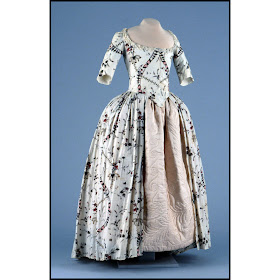The word of the day is Poofy. Gauze and Cotton seem to be taking over the fashion world. You see them used for aprons, trim, caps, bonnets, kerchiefs, petticoats, and gowns. The Duchess of Devonshire and her sisters take over the satires in 1784, pushing for votes in some fashionably fluffy gowns, as well as a few *ahem* attention-getting styles (I'm sure completely made up).
Front
Closure: Almost all closed front, cut-away styles seen as well.
Neckline: Very open, rounded corners (one needs something for modesty).
Skirt opening: Over 8", almost to sides in some cases
Waistline: Pointed, squared, and curved
Back
Style: English backs and Quarter backs very common
Pleats: Very narrow, some inverted for even smaller look on English backs.
Skirt Pleats: About 1/4"
Shoulder Span: Sleeve corner very high and pulling in towards center
Sleeves
1 piece, slim fit, often end below elbow point. Full length sleeves popular with short jackets, occasionally found on gowns.
Trim
Sleeves: Cuff style, bows, or without trim.
Style: Gathered and puffed, simple ribbon, some pleated
Edges: Pinked or folded edge (either roll-hemmed or folded under)
Content: Gauze, self-fabric, and contrast all common
Fabric
Stripes, solid, and some small prints or brocades. Cotton chintz prints becoming popular.
Shape
The front line is bowed out. Very full skirt, in back as well as sides. Bum rolls very common. Flounces on petticoats or gauze overskirts help to balance fullness of polonaised skirts. Kerchiefs often tucked in front for "pigeon breast" look.
CWF Cotton Print Gown, 1780
Met Cotton Print Gown, 1780-85
Met Silk Print Gown, 1780-85
Met Silk Gown, 1780
A Man of War, 1781
The Bird of Paradise, 1781
An English Sloop, 1781
A Rich Privateer, 1782
A City Officer, 1782
Rural Life, 1783
The Citizen at Vauxhall, 1784
March, 1784






















"An English Sloop" 1781 has inspired me to try and make something like that. I love all the trims and accessories. :)
ReplyDeleteVal